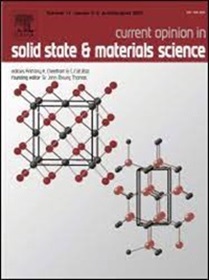Structures, energetics, and dynamics of active tubulin self-organization
IF 13.4
2区 材料科学
Q1 MATERIALS SCIENCE, MULTIDISCIPLINARY
Current Opinion in Solid State & Materials Science
Pub Date : 2025-03-16
DOI:10.1016/j.cossms.2025.101219
引用次数: 0
Abstract
Microtubules (MTs) are one of the major components of the cytoskeleton. They are involved in many key functions of eukaryotic cells, including cell division, intracellular transport, cell motility, and cell shape. MTs are hollow tubules made of parallel filaments, formed by active (non-equilibrium) self-organization of tubulin dimers. The dynamic self-organization of tubulin is facilitated by the GTPase activity of tubulin. Tubulin self-assembles with microtubule-associated proteins (MAPs) and other factors into a wide range of morphologies, including tubulin rings, MT bundles, and the spindle apparatus, segregating chromosomes during cell division. In this review, we shall discuss recent insight into the intimate link between tubulin -biochemistry, -structure, -interactions, -dynamics, -stability, -assembly, -disassembly, and -mechanical properties. We shall then focus on recent time-resolved solution X-ray scattering analysis of tubulin self-organization below and above the critical conditions for microtubule assembly. Finally, we shall discuss some of the challenging multiscale unsolved problems requiring the integration of different experimental and theoretical methods. Microtubule formation is an important target for drugs to treat conditions like gout and a wide range of cancers. Understanding the polymerization mechanism could help in the design of future drugs and in the development of active biomaterials that promote the remodeling or regeneration of tissue after disease or injury.
活性微管蛋白自组织的结构、能量学和动力学
微管是细胞骨架的主要组成部分之一。它们参与真核细胞的许多关键功能,包括细胞分裂、细胞内运输、细胞运动和细胞形状。微管蛋白是由平行细丝组成的空心小管,由微管蛋白二聚体的主动(非平衡)自组织形成。微管蛋白的GTPase活性促进了微管蛋白的动态自组织。微管蛋白与微管相关蛋白(MAPs)和其他因子自组装成多种形态,包括微管蛋白环、MT束和纺锤体,在细胞分裂过程中分离染色体。在这篇综述中,我们将讨论最近对微管蛋白-生物化学,-结构,-相互作用,-动力学,-稳定性,-组装,-拆卸和-机械性能之间密切联系的见解。然后,我们将重点关注微管组装临界条件以下和以上的微管自组织的最新时间分辨溶液x射线散射分析。最后,我们将讨论一些需要整合不同实验和理论方法的具有挑战性的多尺度未解决问题。微管的形成是药物治疗痛风和多种癌症的重要靶点。了解聚合机制可以帮助设计未来的药物和开发活性生物材料,促进疾病或损伤后组织的重塑或再生。
本文章由计算机程序翻译,如有差异,请以英文原文为准。
求助全文
约1分钟内获得全文
求助全文
来源期刊

Current Opinion in Solid State & Materials Science
工程技术-材料科学:综合
CiteScore
21.10
自引率
3.60%
发文量
41
审稿时长
47 days
期刊介绍:
Title: Current Opinion in Solid State & Materials Science
Journal Overview:
Aims to provide a snapshot of the latest research and advances in materials science
Publishes six issues per year, each containing reviews covering exciting and developing areas of materials science
Each issue comprises 2-3 sections of reviews commissioned by international researchers who are experts in their fields
Provides materials scientists with the opportunity to stay informed about current developments in their own and related areas of research
Promotes cross-fertilization of ideas across an increasingly interdisciplinary field
 求助内容:
求助内容: 应助结果提醒方式:
应助结果提醒方式:


